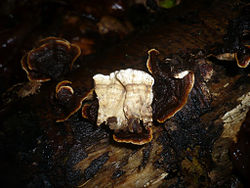| Laxitextum | |
|---|---|
 | |
| Laxitextum bicolor | |
| Scientific classification | |
| Domain: | Eukaryota |
| Kingdom: | Fungi |
| Division: | Basidiomycota |
| Class: | Agaricomycetes |
| Order: | Russulales |
| Family: | Hericiaceae |
| Genus: | Laxitextum Lentz (1956) |
| Type species | |
| Laxitextum bicolor (Pers.) Lentz (1956) | |
| Species | |
Laxitextum is a genus of fungi in the family Hericiaceae. The widespread genus contains three species. [1] It was circumscribed by Paul Lewis Lentz in 1955. [2] Species in the genus have fruit bodies that are effused (stretched out flat) to reflexed (with edges turned up) and a smooth hymenium. Molecular analysis shows that the genus groups in a clade with the genera Hericium and Dentipellis . [3]
